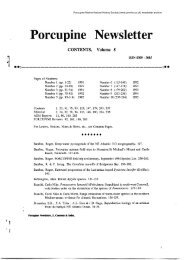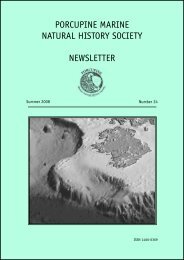Porcupine Newsletter - Porcupine Marine Natural History Society
Porcupine Newsletter - Porcupine Marine Natural History Society
Porcupine Newsletter - Porcupine Marine Natural History Society
You also want an ePaper? Increase the reach of your titles
YUMPU automatically turns print PDFs into web optimized ePapers that Google loves.
Amphioxus.<br />
The Italian, Costa, now enters the story. In<br />
1834, two years before Yarrell’s work appeared,<br />
Costa had published a description of a specimen<br />
that he had found on a Naples shore, placing<br />
it in a new genus - Branchiostoma.. This name<br />
must take date precedence over Amphioxus and<br />
it is now correctly known as Branchiostoma<br />
lanceolatus. As nearly a century elapsed<br />
before Costa’s publication was widely known<br />
it took zoologists a long time to accept that<br />
Amphioxus had become a synonym.<br />
Between 1862 and 1865 Jonathan Couch’s<br />
four volume work, <strong>History</strong> of the Fishes of<br />
the British Isles, was published with fine<br />
illustrations of fish, which he had painted<br />
from life whilst their colours were still vivid.<br />
He recounts a history of the Lancelet in the<br />
fourth volume, giving John Hawkins Esq. as<br />
the person who sent the first specimen to<br />
Peter Pallas.<br />
As for the obscure creature itself, like<br />
the tadpole larva of the tunicates (seasquirts),<br />
it has a dorsal nerve cord, protected<br />
by a notochord, precursor of the vertebrate<br />
backbone. That and various other characters<br />
combine to make it a primitive ancestor of<br />
back-boned animals. It is now known to be<br />
widespread on the shores and in the shallow<br />
water of Britain and mainland Europe. As<br />
it reaches only about 6 cm long, is semitransparent<br />
and very thin, it is not easily found<br />
except by the keenest observers. It occurs in<br />
numbers in the Eddystone gravels, and has<br />
been found in hundreds in the sub-fossil maerl<br />
(calcified seaweed) in the Falmouth area.<br />
Fish farms and jellyfish<br />
Melissa McFadden 1 and Susan Chambers 2<br />
1 Aultnasulaig East, by Laig, Sutherland, IV27 4PA,<br />
2 <strong>Natural</strong> Sciences Department,<br />
National Museums of Scotland, Edinburgh,<br />
EH1 1JF<br />
In recent years there has been a new wave<br />
of anxiety for fish farmers in various parts<br />
of the world due to unpredictable swarms of<br />
jellyfish. The main fish species affected in the<br />
UK are salmon, trout, halibut and cod. In 1997<br />
a Shetland aquaculture company reported that<br />
larval jellyfish had been the cause of death of<br />
two consecutive year classes of sea trout. There<br />
were further reports in 1998 and in August/<br />
September 2002 of attacks on fish farms in the<br />
Western Isles leading to losses of 625 tonnes<br />
of salmon valued at £1.8 million (The Oban<br />
Times 23.05.03). Algal blooms can also be<br />
partly responsible for fish deaths; recent data<br />
was provided by the Fisheries Research Service<br />
(see Figure 1).<br />
These large impacts cause millions of<br />
pounds of stock damage similar in scale to<br />
the loss due to salmon lice. In 2002, a similar<br />
pattern affected Norway; jellyfish were thought<br />
to be responsible for the loss of a thousand<br />
tonnes of fish. Since 1997 Tasmania and New<br />
Zealand have been reporting fish losses due<br />
to jellyfish swarms. Although the popular<br />
press and farm workers have suggested that<br />
scyphozoa have been responsible for farmed<br />
fish mortalities, it is unclear which species<br />
are involved.<br />
Another probable cause of mortality<br />
within the fish pens could be a combination<br />
of factors, such as stress from poor husbandry,<br />
overcrowding, environmental factors and poor<br />
health. Environmental considerations e.g. high<br />
water temperatures, low oxygen saturation,<br />
algal densities, particularly at a time of<br />
plankton blooms, may adversely affect fish<br />
health. Also fish originating from weak genetic<br />
stock are more vulnerable to interference.<br />
Large jellyfish swarms may be due to<br />
different reasons at different times of the<br />
year, but jellyfish are only found in abundance<br />
in Scottish waters, from around April to<br />
September.<br />
Figure 1. Data courtesy of Fisheries Research<br />
Services in Aberdeen.<br />
PMNHS <strong>Newsletter</strong> No.19 Feb 2006 9<br />
<strong>Porcupine</strong> <strong>Marine</strong> <strong>Natural</strong> <strong>History</strong> <strong>Society</strong> (www.pmnhs.co.uk) newsletter archive<br />
9








